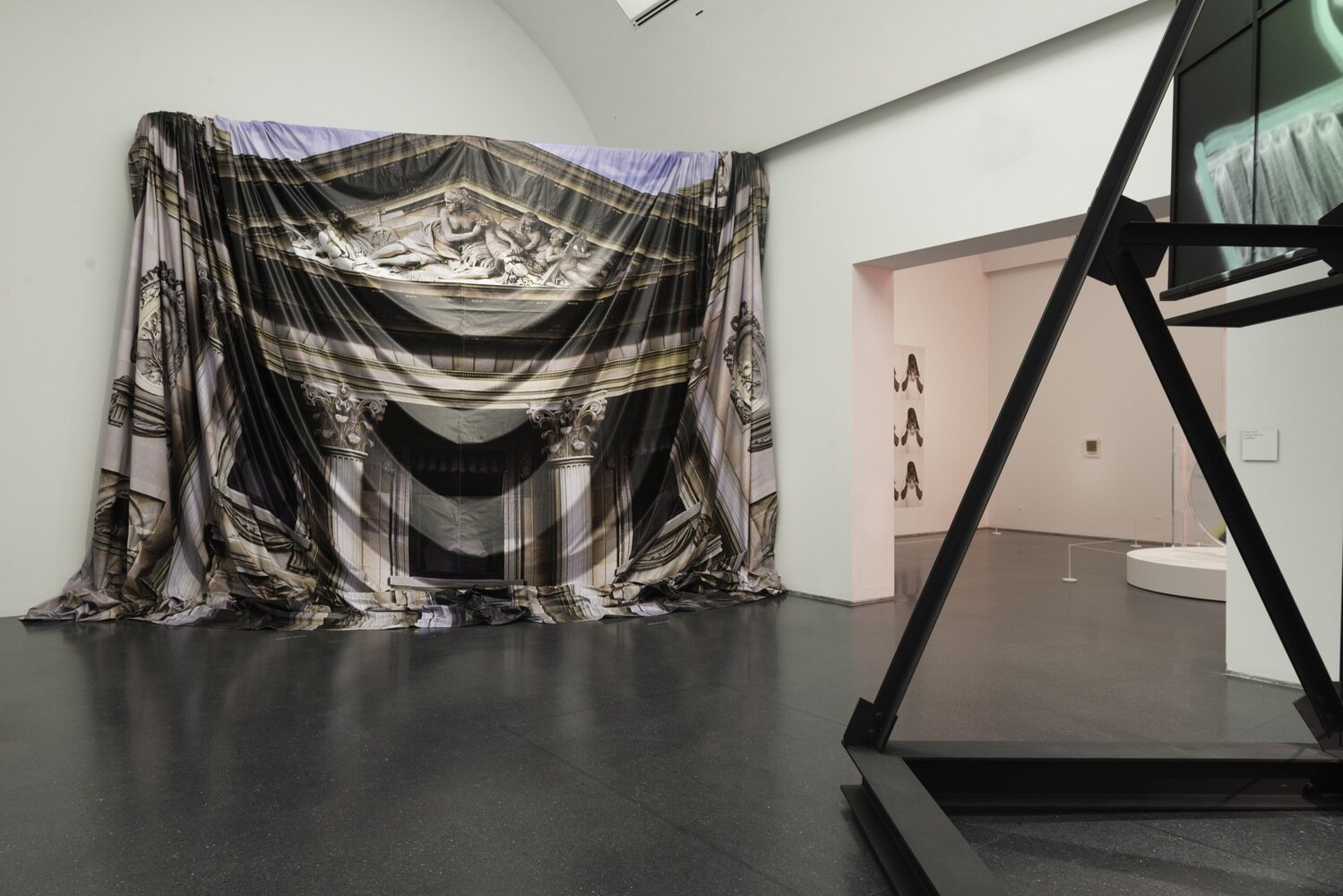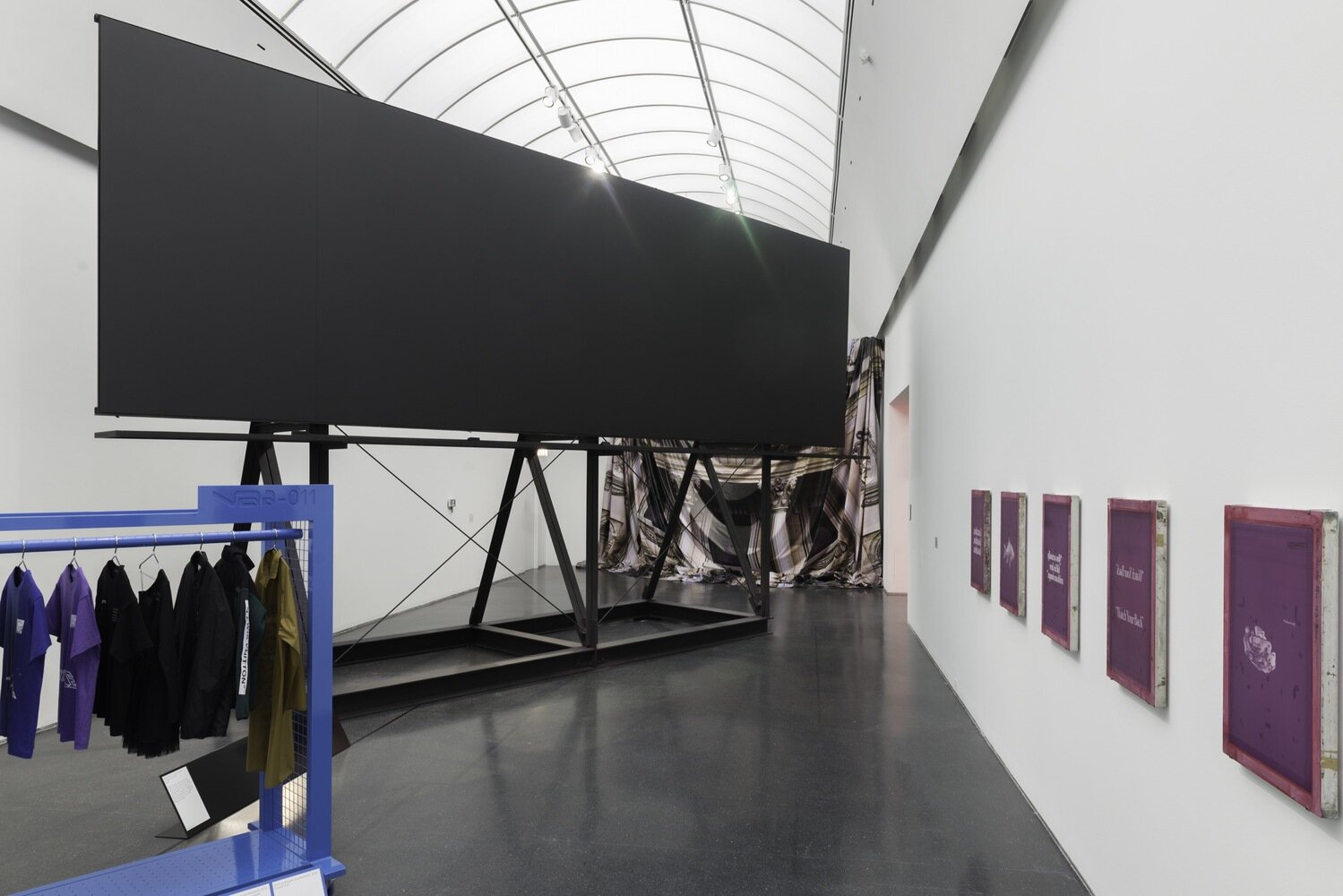Review: Virgil Abloh: "Figures of Speech"
Museum of Contemporary Art Chicago, Chicago, IL, June 10 - September 29, 2019
Image by Nathan Keay, Courtesy of MCA Chicago
From June 10, 2019 to September 29, 2019, the Museum of Contemporary Art Chicago hosted the first exhibition dedicated to the designer Virgil Abloh, entitled Virgil Abloh: “Figures of Speech.” I discovered this exhibition on my first U.S. trip beyond the East Coast on an unrelated research trip to Chicago in June. During an afternoon wandering Downtown Chicago, I saw an advertisement for “Figures of Speech,” and decided to pay a visit to the museum. While no expert in streetwear, I knew of the cultural capital behind the name Virgil Abloh, his associations with the music world and moguls like Kanye West, and the imprint he’s made in the Paris fashion world. When entering the exhibition on the fourth floor of the MCA Chicago in the Griffin Galleries of Art, one sees a call-to-action to listen to the audio guide free of cost. The audio guide was accessible through any smart device on the MCA Chicago’s website [1], so I pulled out my phone, plugged in my headphones, pressed play, and headed into the exhibition.
The thirty minute audio guide, by no means an innovation in museology, is particularly important to “Figures of Speech,” as it includes recognizable guests in Abloh’s world. Meant to enhance the visitor’s experience, the audio guide includes “art curator and historian Hans Ulrich Obrist, fashion critic Amy Verner, and No Vacancy Inn cofounders Tremaine Emory and Acyde, [and] explores Abloh’s career, ethos, and methodology around the creative process.” [2] In the introduction, each guest introduces themselves, allowing the visitor to familiarize themselves with each voice, while also introducing Abloh and his work.
Appropriately situated in Chicago, Abloh’s base (or close enough, as his hometown is actually Rockford, west of Chicago), Virgil Abloh: “Figures of Speech” geographically positioned the ever-moving designer, his legacy and his work in a stationary institution meant for art. In this way, the exhibition positions the designer as an artist, encompassing his branding but also his creative advertising campaigns and collaborations with other brands and companies. It should be noted that the exhibition was not curated by Abloh himself, but by Michael Darling, Chief Curator at the MCA Chicago, who acquainted himself with Abloh in order to bring the show to life. [3] While other exhibition reviews tackle the ironic consumerist approach [4] –– and whether or not it succeeded in its underlying jabs at capitalism –– I will explore the audio guide as a supplement to the exhibition as I experienced it. In juxtaposing the uses of the audio guide with the goals of the exhibition, I hope to elucidate the success of the exhibition while critically looking at the curatorial decisions by the MCA Chicago.
Image by Nathan Keay, Courtesy of MCA Chicago
The audio guide introduces the first gallery, “EARLY WORK,” with Virgil Abloh’s own words: “there's no borders between mediums, only just human-perceived borders.” These words guide the visitor through the first gallery exhibiting Abloh’s early work: Pyrex Vision, his first solo project. In the gallery, there is a film projected onto a white wall, depicting figures wearing sweatshirts that Abloh designed himself for Pyrex. In front of this projection is a rug with a quoted criticism of Pyrex, which Abloh re-appropriated in order to call to the irony in his work and its critics. The rug reads, “it's highly possible Pyrex simply bought a bunch of Rugby flannels, at retail no less, slapped "PYREX 23" on the back and re-sold them for an astonishing markup of about 700%.” [5] According to the guide, Abloh wanted to express the feelings of youth culture with Pyrex. What is youth culture, according to Abloh, then? Is it a sense of irony, a besting of capitalism by selling at comical prices? Abloh says in the audio guide: “I think us as curators or artists or participants in that should do our best job at just freezing it, documenting it,” with it being the current social climate. Abloh does that in his work, freezing the trends of the time, whether it be consumption trends or fashion trends, and so does the curator of this exhibition, by juxtaposing a minimalist rug with a throwback film projection. Tremaine Emory, co-founder of No Vacancy Inn, says in the audio guide: “That's what streetwear is to me. It’s communication, language.” This speaks to Abloh’s sentiment on borders between mediums: it’s a human-perceived border. So, whether in a film, or in a garment, or a rug on the floor of his showroom, Abloh’s work speaks to exactly who it’s meant to in the language of streetwear. The first gallery introduces Abloh’s ethos, supported by the curation of the gallery.
Image by Nathan Keay, Courtesy of MCA Chicago
The voice of Amy Verner, contributing editor to Vogue Runway and Vogue.com, guides the listener into the second room of the exhibition, entitled “FASHION.” “The vision was always bigger than streetwear,” says Verner in the MCA Chicago audio guide, which is clear by the way the gallery is set up. The visitor first sees several racks hung with prototypes of garments Abloh designed. His signature block letters with quotation marks decorate garments. Borrowing from Abloh’s Caravaggio motifs from his streetwear designs, the gallery then builds to a large black billboard and behind it, a large sheet draped on the back wall with a Caravaggio painting printed on it. The message in this gallery, paralleled by Verner’s statements, clearly being bigger than streetwear. Verner calls Abloh a “disruptor” and explains how he did so by creating Off-White, a streetwear brand, and making it luxury by nature of having it created in Milan and showing it in Paris. You can see this disruption realized in the mediation of Abloh’s work in this gallery.
The exhibition then goes back to Virgil Abloh’s roots as a D.J. But, interestingly enough, there isn’t much talk about Abloh’s contributions to Kanye West’s 2013 album, Yeezus, of which there is a huge prototype album cover Abloh designed that greets the visitor as they enter the gallery. In this room there is also a case of expensive jewelry and framed cease and desist letters from the United Nations sent to Abloh for using its official seal on his D.J. fliers. This room, in a sense, shows how Abloh confronted the status quo beyond his work in fashion design. While an interesting room in itself, the audio guide adds little that is relevant to what is displayed, opting instead to discuss Abloh’s artistic involvement in the 2011 collaborative album of Kanye West and Jay-Z, Watch the Throne. This inconsistency was jarring to me, when in the last room, “FASHION,” Verner’s commentary helped narrate the importance of what was already in the room.
Image by Nathan Keay, Courtesy of MCA Chicago
An important aspect of Virgil’s career is that he is the first African American to become artistic director of a European luxury ready-to-wear brand, namely Louis Vuitton, and so when entering the next room entitled “THE BLACK GAZE,” it’s very clear the kind of message the curator wants to send. The only room painted entirely in black, it stands in stark contrast with the other all-white galleries. Images from Abloh’s first ad campaign for Louis Vuitton decorate the wall, displaying black children wearing oversized Louis Vuitton items, but crime scene cones decorate the floors. There’s something eerie yet hopeful about it. In the audio guide, artist and filmmaker Arthur Jafa says, “If you talk about the black gaze, that inevitably has to be bound up with the white gaze.” As the first black designer to be the artistic director of a major European luxury brand, it seems all the gazes are upon Abloh, including the white gaze.
The work of Virgil Abloh, as exemplified through Virgil Abloh: “Figures of Speech,” is the manifestation of postmodern irony, a survey in besting capitalism and making streetwear bigger than its preconceived notions. Through “Figures of Speech,” Chief Curator at the MCA Chicago Michael Darling attempted to document Abloh’s current place in the social climate and pop culture. The audio guide was a complement to that documentation. For those not familiar with Abloh’s work, this guide could help fill in some blanks, while for those who are already fans of the Louis Vuitton artistic director, it can be the frosting on the cake. Though the audio guide was sometimes lackluster in content, as in the “MUSIC” gallery, MCA Chicago’s Virgil Abloh: “Figures of Speech” is a lesson in curating an audio guide to complement––not clash with––the main event: the exhibition.
Notes
[1] “Figures Of Speech Audio,” MCA Chicago, accessed October 4, 2019, https://mcachicago.org/Publications/Websites/Figures-Of-Speech-Audio.
[2] “Virgil Abloh: ‘Figures of Speech,’” MCA Chicago, accessed October 4, 2019, https://mcachicago.org/Exhibitions/2019/Virgil-Abloh.
[3] Natasha Wolff, “An Exclusive Look Inside Virgil Abloh's New Art Exhibition at the MCA In Chicago,” Forbes, June 10, 2019, https://www.forbes.com/sites/natashawolff/2019/06/10/an-excluisve-look-inside-virgil-ablohs-new-art-exhibition-at-the-mca-in-chicago/#372a6ba554d8.
[4] Jon Caramarica, “Can Virgil Abloh Fit in a Museum?,” The New York Times, August 22, 2019, https://www.nytimes.com/2019/08/22/arts/design/virgil-abloh-mca-chicago.html., Evan Moffitt, “Don’t Buy What Virgil Abloh Is Selling,” Frieze, September 20, 2019, https://frieze.com/article/dont-buy-what-virgil-abloh-selling.
[5] Jian Deleon, “No One Pyrex Should Have All Those Rugby Flannels,” Complex, January 4, 2013, https://www.complex.com/style/no-one-pyrex-should-have-all-those-rugby-flannels.






